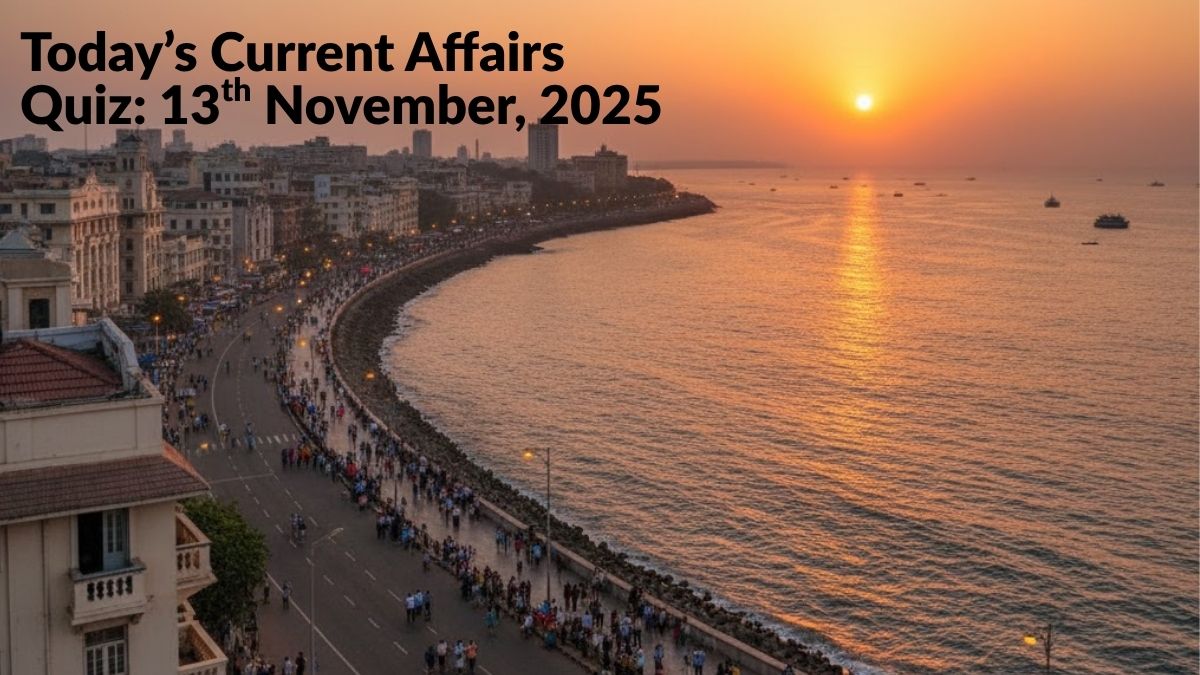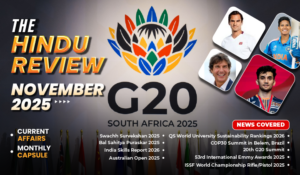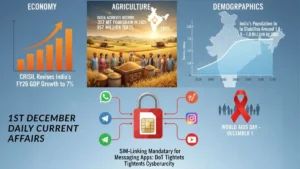Prepare smarter with the 123h November 2025 Current Affairs Quiz! Tackle a diverse range of questions covering the latest updates in Technology, Economy, Policy, Sports, and International Affairs. Ideal for UPSC, SSC, Banking, and Defence aspirants, this quiz ensures consistent revision and better accuracy. Make daily practice a habit to stay ahead of the competition and master your general knowledge section.
Daily Current Affairs: 13 November 2025
Q1. Recently, the Union Cabinet approved the Credit Guarantee Scheme for Exporters (CGSE) to provide 100% credit guarantee coverage through NCGTC for additional credit support up to what amount?
(a) ₹10,000 crore
(b) ₹15,000 crore
(c) ₹20,000 crore
(d) ₹25,000 crore
(e) ₹30,000 crore
The correct answer is (c) ₹20,000 crore.
Explanation:
- The Union Cabinet, chaired by Prime Minister Shri Narendra Modi, has approved the introduction of the Credit Guarantee Scheme for Exporters (CGSE).
- Under this scheme, the National Credit Guarantee Trustee Company Limited (NCGTC) will provide 100% credit guarantee coverage to Member Lending Institutions (MLIs).
- The guarantee covers additional credit facilities up to ₹20,000 crore for eligible exporters, including Micro, Small, and Medium Enterprises (MSMEs).
- The scheme will be implemented by the Department of Financial Services (DFS) through NCGTC.
- A Management Committee, chaired by the Secretary, DFS, will monitor and oversee the implementation.
- CGSE aims to enhance the global competitiveness of Indian exporters and help them reach new and emerging international markets.
- The scheme enables collateral-free credit, improving liquidity and ensuring smooth functioning of export operations.
- It supports India’s goal of achieving USD 1 trillion in exports, contributing to the vision of Aatmanirbhar Bharat (Self-reliant India).
Q2. Consider the following statements regarding the Export Promotion Mission (EPM):
- EPM has a financial outlay of ₹25,060 crore for the period FY 2025–26 to FY 2030–31.
- The Mission will operate through two integrated sub-schemes: NIRYAT PROTSAHAN and NIRYAT DISHA.
- EPM replaces the Interest Equalisation Scheme (IES) entirely and does not include the Market Access Initiative (MAI).
- The Mission aims to simplify export operations through a dedicated digital platform operated by DGFT.
Which of the above statements are correct?
(a) 1, 2 and 3 only
(b) 1, 3 and 4 only
(c) 1 and 4 only
(d) 2, 3 and 4 only
(e) 1,2 and 4 only
The correct answer is (e) 1, 2 and 4 only.
Explanation:
- The Union Cabinet chaired by Prime Minister Shri Narendra Modi has approved the Export Promotion Mission (EPM), a flagship initiative announced in the Union Budget 2025–26 to boost India’s export competitiveness.
- The Mission primarily targets MSMEs, first-time exporters, and labour-intensive sectors.
- EPM has a total outlay of ₹25,060 crore for the period FY 2025–26 to FY 2030–31. Hence statement 1 is correct.
- It aims to create a comprehensive, flexible, and digitally enabled export promotion framework.
- The Mission represents a shift from multiple fragmented schemes to a single, outcome-based and adaptive mechanism capable of responding quickly to global trade challenges.
- EPM will operate through a collaborative structure involving: Department of Commerce, Ministry of MSME, Ministry of Finance and other key stack holders such as Financial institutions, Export Promotion Councils, Commodity Boards, industry bodies, and state governments
Two Integrated Sub-Schemes
- NIRYAT PROTSAHAN:
- Enhances access to affordable trade finance for MSMEs.
- Key instruments include: Interest subvention, Export factoring, Collateral guarantees, Credit cards for e-commerce exporters and Credit enhancement support for market diversification
- NIRYAT DISHA:
- Focuses on non-financial export enablers to boost market readiness.
- Support includes: Quality and compliance assistance, International branding and packaging support, Participation in global trade fairs, Export warehousing and logistics, Inland transport reimbursements and Trade intelligence and capacity-building initiatives. Hence, statement 2 is correct.
Key Features and Objectives:
- Consolidates existing schemes like the Interest Equalisation Scheme (IES) and Market Access Initiative (MAI). Hence statement 3 is incorrect.
- Addresses structural constraints such as:
- Limited and costly access to trade finance
- High international compliance costs
- Weak export branding and fragmented market access
- Logistical challenges in interior and low-export-intensity regions
- Priority support to sectors impacted by recent global tariff hikes, including: Textiles, Leather, Gems & jewellery, Engineering goods and Marine products
Implementation: The Directorate General of Foreign Trade (DGFT) will serve as the implementing agency, with all processes—from application to disbursal—executed through a dedicated digital platform integrated with existing trade systems. Hence statement 4 is correct.
Q3. According to the WHO Global TB Report 2025, India reduced its TB incidence from 237 cases per lakh in 2015 to ________, marking a decline of ________, nearly twice the global average reduction rate.
(a) 200 per lakh; 10%
(b) 187 per lakh; 21%
(c) 150 per lakh; 28%
(d) 175 per lakh; 18%
(e) 165 per lakh; 25%
The correct answer is (b) 187 per lakh; 21%.
Explanation:
- India achieved a 21% reduction in tuberculosis (TB) incidence between 2015 and 2024, almost twice the global rate of decline, as per the WHO Global TB Report 2025.
- TB incidence in India fell from 237 cases per lakh (2015) to 187 cases per lakh (2024), representing one of the sharpest declines among high-burden countries.
- Treatment coverage improved significantly from 53% in 2015 to over 92% in 2024.
- Out of the estimated 27 lakh TB cases in 2024, around 26.18 lakh patients were successfully diagnosed and put on treatment.
- The number of “missing cases” (patients not reported to the national programme) reduced drastically from 15 lakh (2015) to less than 1 lakh (2024).
- India has also maintained stability in multi-drug resistant TB (MDR-TB) cases.
- Under the TB Mukt Bharat Abhiyan, the treatment success rate has improved to 90%, surpassing the global average of 88%.
- TB mortality declined from 28 per lakh (2015) to 21 per lakh (2024).
- These achievements have been strongly supported by a ten-fold increase in government funding for the national TB programme over the last nine years.
Q4. According to the Climate Risk Index (CRI) 2026 released by Germanwatch, India has been ranked as one of the countries most affected by climate-related disasters over the past 30 years. What is India’s current rank in the long-term CRI list?
(a) 5th
(b) 7th
(c) 8th
(d) 9th
(e) 10th
The correct answer is (d) 9th.
Explanation:
- The Climate Risk Index (CRI) 2026 was released by Germanwatch, a Bonn-based NGO, during COP30 at Belém, Brazil.
- The CRI ranks countries based on the impacts of extreme weather events, including fatalities, people affected, and economic losses.
- The index has been published annually since 2006 and is among the longest-running climate impact-based assessments.
India’s Ranking
- India ranked 9th among the countries worst affected by climate-related disasters over the last 30 years.
- In the previous CRI report (2023), India was ranked 8th, indicating slight improvement.
- India’s rank for climate disasters in the previous year alone improved from 10 (2023) to 15, suggesting improved resilience.
Key Findings
- Globally, 8.32 lakh people died due to extreme weather events between 1995–2024.
- India alone accounted for 80,000 deaths, which is 9.6% of global climate-related fatalities.
- India experienced 430 extreme weather events in the last three decades, including floods, droughts, cyclones, and heatwaves.
- The economic loss from these disasters amounted to USD 170 billion.
- Among the most affected countries in the long-term Climate Risk Index ranking, Dominica ranks first, followed by Myanmar and Honduras. The report highlights that Small Island Developing States (SIDS) face the greatest climate-related impacts despite contributing the least to global emissions. For the year 2024, St. Vincent and the Grenadines, Grenada, and Chad emerged as the most affected countries.
Q5. In November 2025, a new American envoy formally took oath as the United States Ambassador to India during a ceremony held at the Oval Office of the White House. Who among the following assumed this position?
(a) Richard Verma
(b) Eric Garcetti
(c) Sergio Gor
(d) Nicholas Burns
(e) Kurt Campbell
The correct answer is (c) Sergio Gor.
Explanation:
- Sergio Gorwas formally sworn in as the United States Ambassador to India on 11 November 2025.
- The oath-taking ceremony was held at the Oval Office, located in the White House.
- At 38 years of age, Sergio Gor becomes one of the younger US envoys appointed to India.
- He previously served as the Director of Presidential Personnel in the Trump administration, where he managed crucial functions related to White House staffing and executive coordination.



 The Hindu Review November 2025, Download...
The Hindu Review November 2025, Download...
 Daily Current Affairs News: 4th December...
Daily Current Affairs News: 4th December...
 Daily Current Affairs News: 1st December...
Daily Current Affairs News: 1st December...








